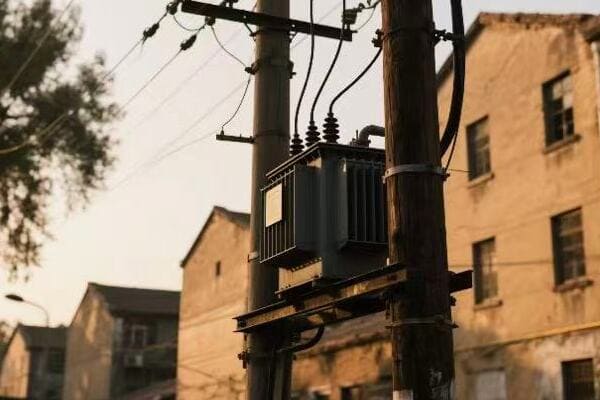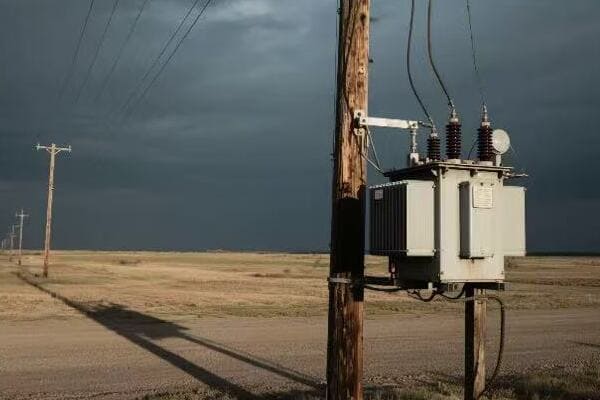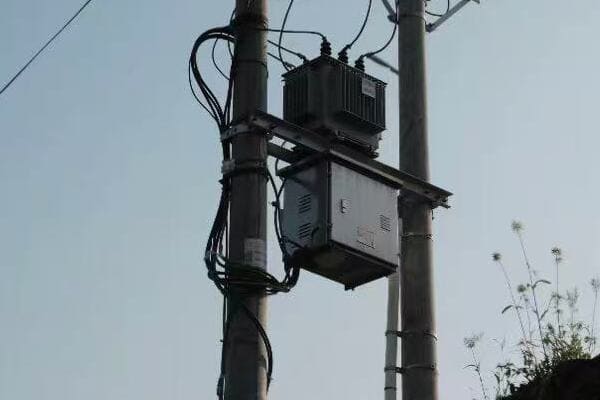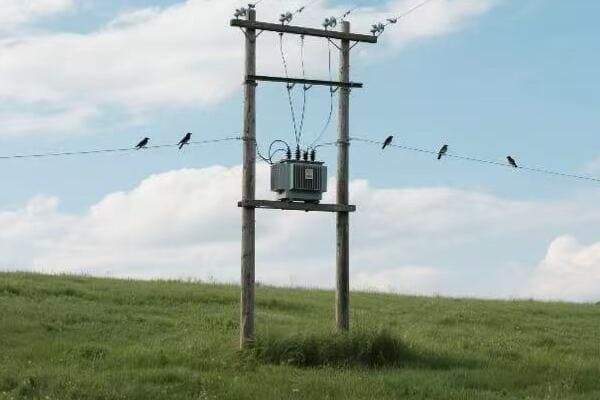Types of Telephone Pole Transformers: Which One Fits Your Grid Needs?
Are you confused about which type of pole transformer is best for your electrical grid? You’re not alone. Many people find it challenging to choose the right transformer for their specific needs.
Choosing the right pole transformer depends on your grid’s voltage requirements, load capacity, and specific application. Options include single-phase, three-phase, conventional, smart, step-up, step-down, and specialized transformers like autotransformers and padmounts. Each type serves different purposes in power distribution systems.

In this article, I’ll guide you through the different types of pole transformers. We’ll explore their features, applications, and how to select the best one for your needs. Let’s dive in and demystify the world of pole transformers together.
Single-Phase vs. Three-Phase Pole Transformers: Understanding the Basics and Applications?
Have you ever wondered why some areas have different types of transformers? The choice between single-phase and three-phase transformers can significantly impact power distribution efficiency and reliability.
Single-phase transformers are typically used in residential areas with lower power demands. Three-phase transformers are more common in industrial and commercial settings where higher power capacity is needed. The choice depends on the load requirements and the existing power infrastructure.

Diving Deeper into Single-Phase and Three-Phase Transformers
Let’s break down the key differences and applications of these two transformer types:
Single-Phase Transformers
-
Basic Structure
- Two windings: primary and secondary
- Simpler design compared to three-phase
-
Applications
- Residential areas
- Rural power distribution
- Small businesses with low power needs
-
Advantages
- Cost-effective for low power requirements
- Easier to install and maintain
- Suitable for areas with unbalanced loads
Three-Phase Transformers
-
Basic Structure
- Three sets of windings
- More complex design
-
Applications
- Industrial facilities
- Large commercial buildings
- Urban power distribution
-
Advantages
- Higher efficiency in power transmission
- Better suited for heavy machinery and equipment
- More stable power supply for large loads
Comparing Single-Phase and Three-Phase Transformers
Here’s a comparison table to help you understand the differences:
| Feature | Single-Phase | Three-Phase |
|---|---|---|
| Power Capacity | Lower | Higher |
| Efficiency | Good for small loads | Better for large loads |
| Cost | Lower initial cost | Higher initial cost, but more efficient long-term |
| Size | Smaller | Larger |
| Typical Voltage | 120/240V | 208/120V or 480/277V |
| Load Balancing | Not applicable | Required for optimal performance |
In my experience, choosing between single-phase and three-phase transformers often comes down to the specific needs of the area. I once worked on a project in a small rural town where we opted for single-phase transformers. The lower power demands and scattered population made it the most cost-effective solution. However, when I was involved in upgrading the power supply for a new industrial park, we went with three-phase transformers to handle the high power requirements of the manufacturing equipment.
The key is to assess your current and future power needs carefully. If you’re in a residential area with no plans for significant industrial development, single-phase transformers are likely your best bet. But if you’re in a rapidly growing area or one with industrial aspirations, investing in three-phase infrastructure could save you money and headaches in the long run.
Conventional and Smart Pole Transformers: Comparing Features for Modern Grid Needs?
Are you still relying on conventional transformers, or have you considered upgrading to smart ones? The choice between conventional and smart pole transformers can significantly impact your grid’s efficiency and reliability.
Conventional pole transformers are traditional, reliable, and cost-effective for basic power distribution. Smart transformers offer advanced features like real-time monitoring, automatic voltage regulation, and data communication capabilities, making them ideal for modern, responsive grid systems.

Exploring the World of Conventional and Smart Transformers
Let’s delve into the features and benefits of both types:
Conventional Transformers
-
Basic Features
- Simple design focused on voltage transformation
- Passive operation without monitoring capabilities
- Reliable and time-tested technology
-
Advantages
- Lower initial cost
- Less complex, easier to maintain
- Suitable for areas with stable power demands
-
Limitations
- No real-time monitoring or data collection
- Manual intervention required for adjustments
- Limited adaptability to changing grid conditions
Smart Transformers
-
Advanced Features
- Real-time monitoring and data collection
- Automatic voltage regulation
- Remote control and communication capabilities
- Integration with smart grid systems
-
Advantages
- Improved grid efficiency and reliability
- Faster response to power quality issues
- Better load management and forecasting
- Enhanced integration of renewable energy sources
-
Considerations
- Higher initial cost
- More complex, requiring specialized maintenance
- Cybersecurity considerations
Comparing Conventional and Smart Transformers
Here’s a detailed comparison to help you understand the differences:
| Feature | Conventional Transformers | Smart Transformers |
|---|---|---|
| Monitoring | Manual inspections | Real-time, continuous |
| Data Collection | Limited, manual | Extensive, automated |
| Voltage Regulation | Fixed or manual tap changing | Automatic, dynamic |
| Communication | None | Two-way with control center |
| Fault Detection | Reactive, after occurrence | Proactive, predictive |
| Integration with Renewables | Limited | Advanced, with load balancing |
| Initial Cost | Lower | Higher |
| Maintenance | Simpler, less frequent | More complex, but potentially less frequent |
| Lifespan | Typically longer | Potentially shorter due to electronic components |
In my career, I’ve worked with both conventional and smart transformers. I remember a project where we upgraded a suburban area from conventional to smart transformers. Initially, there was hesitation due to the higher costs. However, within a year, we saw significant improvements in power quality and reduced outage times. The ability to detect and respond to issues before they escalated was a game-changer.
That said, smart transformers aren’t always the best choice. In remote areas with limited communication infrastructure, the advanced features of smart transformers might not be fully utilized. In such cases, the reliability and simplicity of conventional transformers can be more appropriate.
The decision between conventional and smart transformers should be based on your specific grid needs, future growth plans, and budget constraints. Smart transformers shine in areas with fluctuating loads, high renewable energy integration, or where power quality is a major concern. Conventional transformers remain a solid choice for stable, predictable power needs where advanced monitoring isn’t critical.
Step-Up and Step-Down Pole Transformers: Choosing the Right Voltage Transformation?
Are you struggling to decide between step-up and step-down transformers for your power distribution needs? This choice is crucial for ensuring efficient and safe power transmission across different parts of the grid.
Step-up transformers increase voltage for efficient long-distance transmission, while step-down transformers reduce voltage for safe local distribution and consumption. The choice depends on where the transformer is placed in the power distribution chain and the voltage requirements of the connected systems.

Understanding Step-Up and Step-Down Transformers
Let’s explore the characteristics and applications of both types:
Step-Up Transformers
-
Function
- Increase voltage from generation level to transmission level
- Typically used at power plants
-
Advantages
- Reduces power loss over long distances
- Allows for more efficient power transmission
-
Applications
- Power plants to transmission lines
- Renewable energy sources to grid connection
Step-Down Transformers
-
Function
- Decrease voltage from transmission level to distribution level
- Further step down voltage for end-user consumption
-
Advantages
- Makes high voltage power safe for local use
- Allows for proper voltage levels in homes and businesses
-
Applications
- Substations to local distribution
- Pole-mounted transformers in neighborhoods
Comparing Step-Up and Step-Down Transformers
Here’s a detailed comparison to help you understand the differences:
| Feature | Step-Up Transformers | Step-Down Transformers |
|---|---|---|
| Primary Function | Increase voltage | Decrease voltage |
| Typical Location | Power generation sites | Distribution points, neighborhoods |
| Winding Ratio | Secondary > Primary | Primary > Secondary |
| Current Change | Decreases current | Increases current |
| Power Loss Mitigation | Reduces transmission losses | N/A |
| Safety Considerations | Handles very high voltages | Makes power safe for end-use |
| Size | Generally larger | Varies, often smaller in distribution |
In my experience, the choice between step-up and step-down transformers is often dictated by the transformer’s position in the power distribution chain. I once worked on a project for a new solar farm where we needed step-up transformers to connect the generated power to the main grid. The farm produced power at around 400V, but we needed to step it up to 69kV for efficient transmission to the nearby substation.
On the other hand, in urban development projects, I’ve frequently used step-down transformers. In one case, we were setting up a new residential area. We had to step down the voltage from the 13.8kV distribution lines to 120/240V for household use. This required careful planning to ensure we had the right number and capacity of transformers to meet the neighborhood’s power demands.
The key to choosing between step-up and step-down transformers lies in understanding your power system’s structure and requirements. Here are some considerations:
- Voltage Requirements: Assess the input voltage and the required output voltage.
- Power Source: Are you connecting a generation source to the grid or distributing power to end-users?
- Distance: For long-distance transmission, step-up transformers are crucial to minimize power losses.
- Safety: In areas close to end-users, step-down transformers are essential for providing safe, usable voltage levels.
Remember, in many cases, you’ll need both types at different points in your power system. A well-designed power distribution network often incorporates a series of step-up and step-down transformers to efficiently move electricity from generation to consumption.
Specialized Pole Transformers: Autotransformers, Padmounts, and Their Unique Uses?
Have you encountered situations where standard transformers just don’t cut it? Specialized transformers like autotransformers and padmounts offer unique solutions for specific power distribution challenges.
Autotransformers are efficient for small voltage changes and can be more compact than traditional transformers. Padmount transformers are ground-mounted units ideal for underground distribution systems. These specialized types offer tailored solutions for unique power distribution needs in various settings.

Diving into Specialized Transformer Types
Let’s explore the characteristics and applications of these specialized transformers:
Autotransformers
-
Basic Structure
- Single winding acts as both primary and secondary
- Portion of the winding is shared between input and output
-
Advantages
- More efficient for small voltage changes
- Smaller and lighter than two-winding transformers
- Lower cost for same power rating
-
Applications
- Voltage regulation in distribution systems
- Interconnecting systems with slightly different voltages
- Motor starting applications
Padmount Transformers
-
Basic Structure
- Ground-mounted, enclosed in a steel cabinet
- Can be single-phase or three-phase
-
Advantages
- Aesthetically pleasing, suitable for residential areas
- Safer due to locked enclosure
- Ideal for underground distribution systems
-
Applications
- Urban and suburban power distribution
- Commercial and industrial parks
- Areas where overhead lines are not feasible or desired
Comparing Autotransformers and Padmount Transformers
Here’s a detailed comparison to help you understand these specialized types:
| Feature | Autotransformers | Padmount Transformers |
|---|---|---|
| Primary Use | Voltage adjustment | Distribution in underground systems |
| Size | Compact | Larger, ground-mounted |
| Efficiency | High for small voltage changes | Similar to standard transformers |
| Cost | Lower for same power rating | Higher due to enclosure and features |
| Safety | Less isolation between circuits | Enhanced safety with locked enclosure |
| Aesthetics | Similar to standard transformers | More visually appealing |
| Installation | Can be pole-mounted or pad-mounted | Ground-mounted only |
| Maintenance | Generally simpler | May require specialized access |
In my career, I’ve encountered numerous situations where these specialized transformers proved invaluable. I remember a project in a historic district where overhead lines were prohibited. We used padmount transformers to create an underground distribution system that preserved the area’s aesthetic while providing reliable power.
Another interesting case involved an industrial facility that needed to interconnect two systems with a small voltage difference. An autotransformer was the perfect solution, offering efficient voltage adjustment without the need for a full-sized traditional transformer.
When considering these specialized transformers, keep in mind:
- Voltage Change Requirements: Autotransformers are ideal for small voltage adjustments, typically up to 20%.
- Space Constraints: In areas with limited space, autotransformers can be a compact solution.
- Aesthetic Concerns: Padmount transformers are excellent for areas where visual impact is a concern.
- Underground Systems: If you’re designing an underground distribution system, padmount transformers are often the go-to choice.
- Safety Needs: In areas with high foot traffic or public access, the locked enclosures of padmount transformers offer added safety.
Remember, while these specialized transformers offer unique benefits, they also come with their own set of considerations. Autotransformers, for instance, provide less electrical isolation between primary and secondary circuits, which may be a concern in some applications. Padmount transformers, while visually appealing and safe, can be more expensive and may require special equipment for installation and maintenance.
Environmental Considerations: Selecting Pole Transformers for Different Climate Zones?
Have you ever wondered why the same transformer might perform differently in different parts of the world? The impact of environmental factors on transformer performance is often underestimated, but it’s crucial for ensuring reliability and longevity.
Selecting the right pole transformer for different climate zones involves considering factors like temperature extremes, humidity, altitude, and pollution levels. Transformers must be designed to withstand local environmental challenges to ensure optimal performance and longevity in diverse climatic conditions.

Adapting Transformers to Various Climate Zones
Let’s explore how different climate factors affect transformer selection and design:
Hot and Humid Climates
-
Challenges
- High ambient temperatures
- Increased risk of overheating
- Accelerated insulation degradation
-
Solutions
- Enhanced cooling systems (e.g., forced oil circulation)
- Use of heat-resistant materials
- Dehumidifiers to control moisture
-
Examples
- Tropical regions, Middle East
Cold Climates
-
Challenges
- Extremely low temperatures
- Risk of oil freezing
- Thermal cycling stress
-
Solutions
- Low-temperature grade insulating oils
- Heaters for extreme cold conditions
- Reinforced tank designs for thermal expansion
-
Examples
- Arctic regions, high-altitude areas
Coastal and High-Pollution Areas
-
Challenges
- Salt spray corrosion
- Industrial pollution
- Increased risk of insulator flashover
-
Solutions
- Corrosion-resistant materials and coatings
- Specially designed insulators (e.g., silicone rubber)
- More frequent maintenance schedules
-
Examples
- Coastal industrial zones, heavily polluted urban areas
High-Altitude Regions
-
Challenges
- Reduced air density affecting cooling
- Increased risk of corona discharge
- Lower dielectric strength of air
-
Solutions
- Adjusted cooling calculations
- Enhanced insulation systems
- Special bushing designs
-
Examples
- Mountain regions, high-plateau areas
Comparing Transformer Designs for Different Climates
Here’s a comparison table of transformer features for various climate zones:
| Feature | Hot & Humid | Cold Climate | Coastal/High-Pollution | High-Altitude |
|---|---|---|---|---|
| Cooling System | Enhanced, often forced | Standard, with heating options | Standard, with corrosion protection | Adjusted for lower air density |
| Insulating Oil | High temperature grade | Low temperature grade | Standard, with moisture resistance | Standard, with adjusted volume |
| Tank Design | Extra corrosion protection | Reinforced for thermal cycling | Heavy-duty corrosion protection | Standard, with pressure considerations |
| Bushings | Extended creepage | Cold-resistant materials | Pollution-resistant (e.g., silicone) | Corona-resistant design |
| Maintenance Frequency | Higher | Standard | Higher | Standard, with specific checks |
In my years of experience, I’ve encountered numerous challenges related to climate-specific transformer design. I recall a project in a tropical coastal area where we faced a perfect storm of high heat, humidity, and salt spray. We had to completely rethink our standard transformer design.
We ended up using a combination of forced oil cooling, corrosion-resistant stainless steel tanks, and silicone rubber insulators. The initial cost was higher, but the long-term savings in maintenance and increased reliability made it worthwhile. The client was initially skeptical about the custom design, but after two years of operation with zero weather-related issues, they were fully convinced.
When selecting transformers for different climate zones, consider these key points:
- Temperature Range: Understand the full range of temperatures the transformer will face, not just averages.
- Humidity and Precipitation: High humidity can lead to condensation inside the transformer, while heavy rain or snow can stress the outer components.
- Altitude: For every 100m above 1000m, you generally need to derate the transformer by about 0.4%.
- Pollution Levels: In areas with high industrial pollution or coastal salt spray, consider the Pollution Severity Index when selecting insulation.
- Wind and Seismic Activity: In areas prone to high winds or earthquakes, mechanical strength becomes a crucial factor.
- Local Regulations: Some regions have specific requirements for transformer design and installation based on their environmental conditions.
Remember, a transformer that works perfectly in one climate might fail prematurely in another. It’s not just about making the transformer work; it’s about ensuring it works efficiently and reliably for its entire expected lifespan. Sometimes, investing in a more robust design upfront can lead to significant savings in maintenance and replacement costs down the line.
In one interesting case, we were tasked with designing transformers for a mining operation in a high-altitude desert environment. We faced the dual challenge of thin air affecting cooling and extreme temperature swings between day and night. Our solution involved a custom cooling system designed for the lower air density and special insulating oil that could handle the temperature fluctuations without degrading. It was a complex project, but it taught me the importance of considering multiple environmental factors simultaneously.
The key takeaway is that there’s no one-size-fits-all solution when it comes to transformer design for different climate zones. Each environment presents its unique set of challenges, and the best approach is often a customized design that takes all local factors into account. As engineers and designers, it’s our job to understand these nuances and create solutions that ensure reliable power distribution, regardless of the environmental challenges.
Conclusion
Choosing the right pole transformer is crucial for efficient and reliable power distribution. Consider factors like phase requirements, smart capabilities, voltage needs, specialized applications, and environmental conditions. Each type has its strengths, and the best choice depends on your specific grid needs and local climate.
Free CHBEB Transformer Catalog Download
Get the full range of CHBEB transformers in one catalog.
Includes oil-immersed, dry-type, pad-mounted, and custom solutions.
Quick Message
Request A free quote
We'd like to work with you
- +86 15558785111
- [email protected]
- +86 15558785111
What We Do
CHINA BEI ER BIAN (CHBEB) GROUP, with 218 million in registered capital, originated from Beijing Beierbian Transformer Group. Headquartered in Beijing for R&D, it operates major production bases in Nanjing and Yueqing, producing high-quality products.
Latest Product
address
BeiJing
No 3,RongJing East Road,BeiJing Economic Technological Development Area,BeiJing,China
JiangSu
No 7️Xiangfeng Road,Jiangning,NanJing,JiangSu,China
WenZhou
No.211, Wei 16 Road, Industrial Zone, Yueqing, Wenzhou, Zhejiang, China.
XiangYang Industrial Zone ,YueQing,WenZhou,ZheJiang,China
contact us
- [email protected]
- +86 13057780111
- +86 13057780111
- +86 15558785111
Copyright © Bei Er Bian Group


